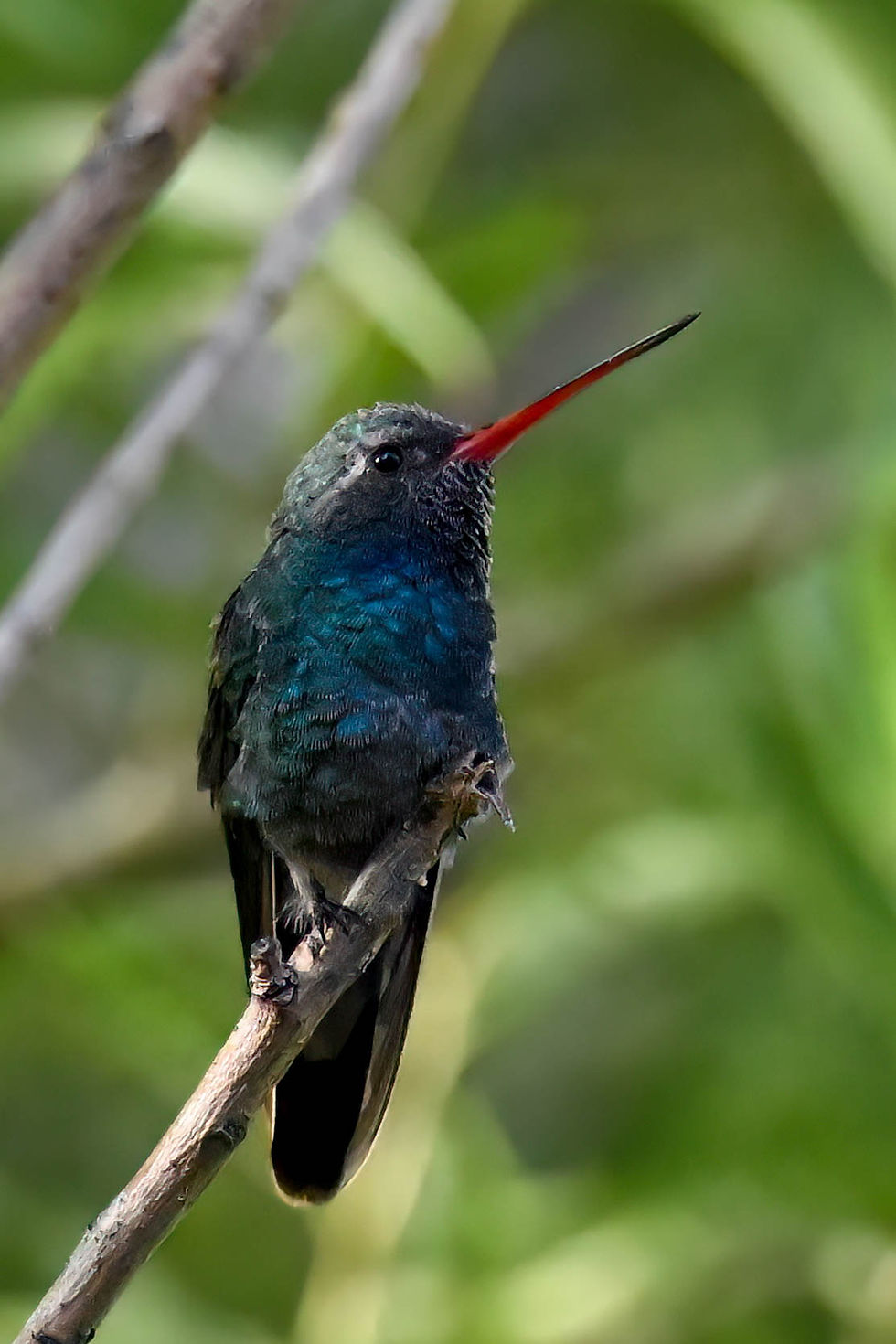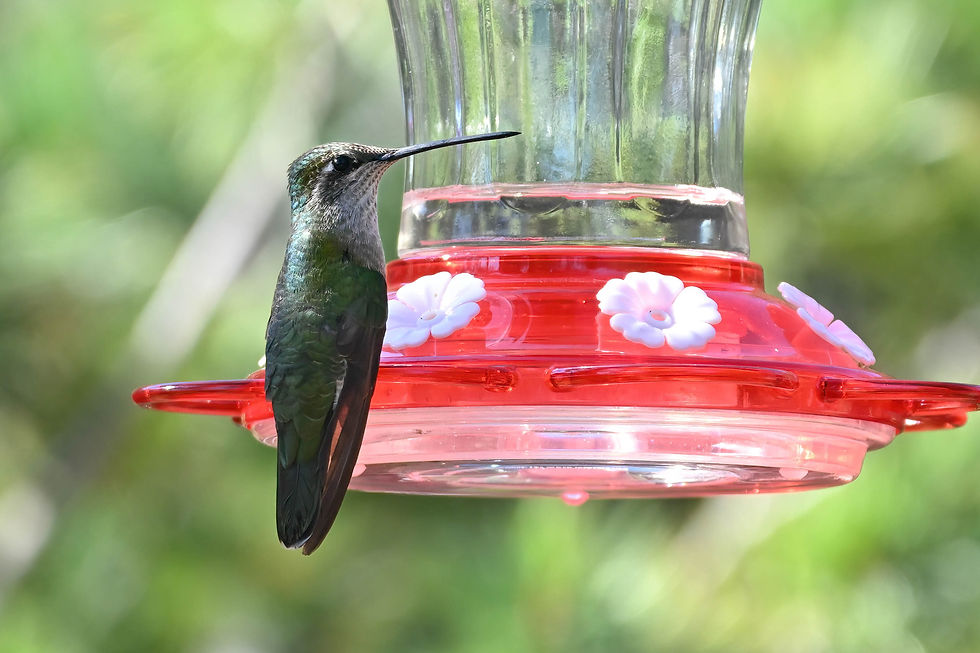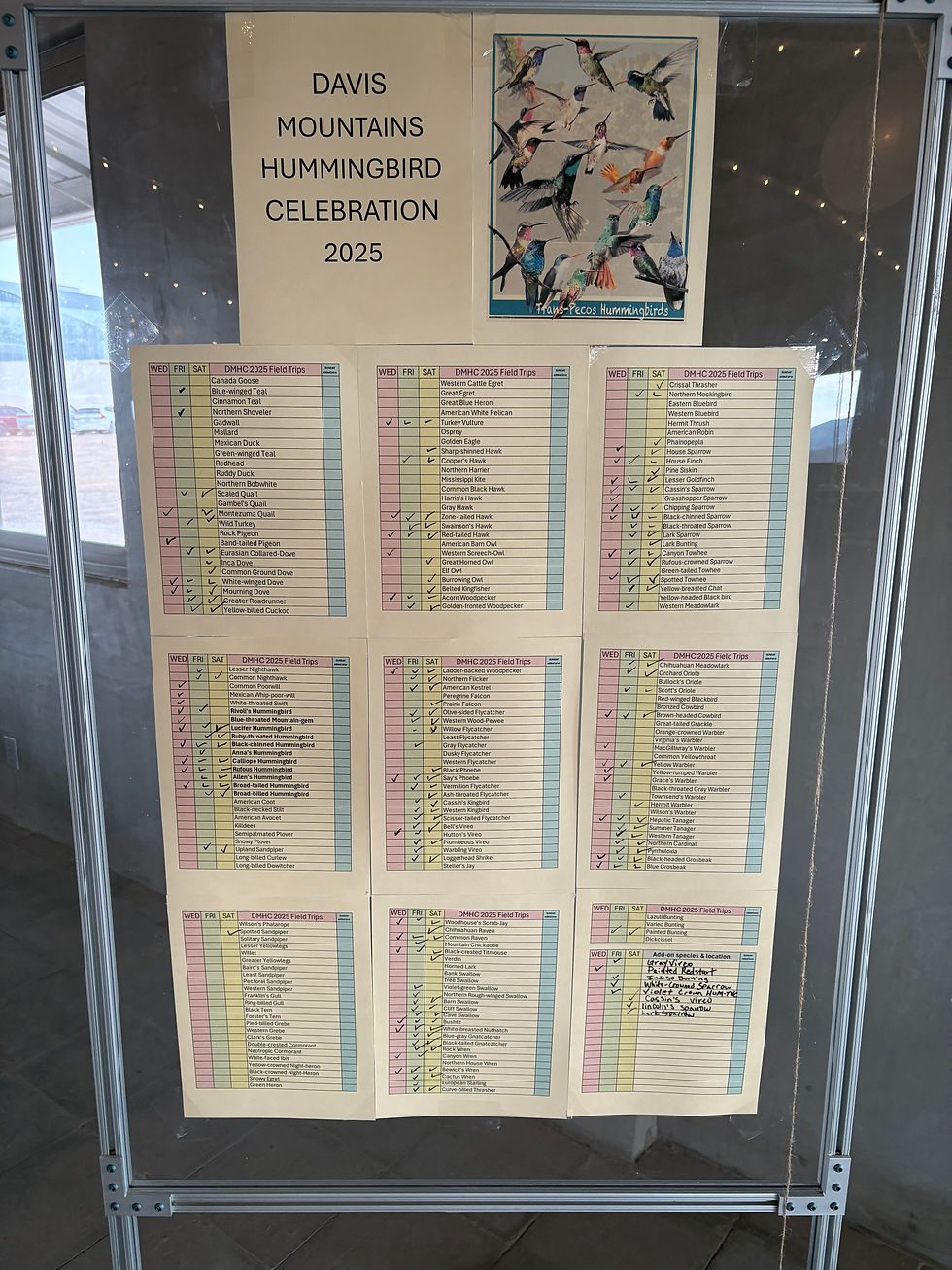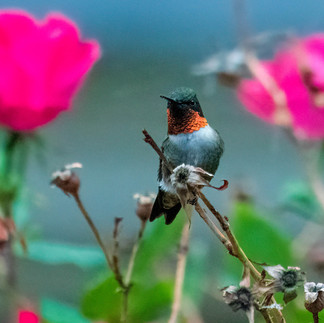The Magic of a Hummingbird Celebration
- Vicki Wilmarth

- Aug 31
- 5 min read

It is unusual for any Texan to travel south in August. Everyone heads for the Rockies, the Great Lakes or Iceland, if they are lucky, to escape the heat. But several of our intrepid birder friends joined Rohn and me as we voluntarily left Amarillo and headed south in mid-August to attend the Davis Mountains Hummingbird Celebration. The elevations around Fort Davis are higher, but that doesn't necessarily make the area any cooler (temperature-wise). But what is cool is the number of hummingbirds that migrate through these higher elevations in August on their way south for the winter.

These little jewel-like birds attracted 175 participants to the biennial event held at the rustic High Frontier lodge in Fort Davis. The Trans-Pecos Birds group skillfully organized morning field trips to homes, ranches, parks and conservancies where hummingbirds and other West Texas specialty birds could be found. In the afternoons, birding experts gave presentations, and in the evenings, everyone gathered to socialize. The Panhandle Bird Club was well-represented and enjoyed the time together immensely.


In Amarillo/Canyon, we only see five species of hummingbirds each year. The most common are Black-chinned Hummingbirds, who arrive in the spring, stay all summer because they nest in our area, and then leave sometime in the fall.

During migration, particularly fall migration, we get to see Rufous, Ruby-throated and Broad-tailed Hummingbirds in Amarillo. They drop down to fuel up at our feeders and flowers for a few days and then move further south.
In late July 2025, I had a thrill when I spotted a Calliope Hummingbird in my yard for the first time. Calliopes are the smallest (less than 3" long) bird native to North America. These showy birds breed in high-altitude areas of the western U.S. and British Columbia and then migrate to southern Mexico for the winter. It is an arduous journey of 5000 miles annually that these tiny birds make. Infrequently, they pass through Amarillo during fall migration. This one stayed about a week in my yard before disappearing.

I actually saw a local person on Facebook comment that hummingbirds don't ever visit Amarillo. I wanted to say, "Yes, Virginia, there are hummingbirds in Amarillo". But I restrained myself. What I did realize from that comment was that just looking for hummingbirds locally is limited. Seeing only the five species of hummingbirds that regularly visit Amarillo for only a few days wasn't enough for me. Because they are the dazzlers of the bird world and, admittedly, because they are an interesting challenge to photograph, I really wanted to see more varieties of hummingbirds. So the Hummingbird Celebration in Fort Davis seemed just the ticket.
One of my target birds for the festival when we signed up in May was to see a Broad-billed Hummingbird. These metallic green and blue beauties with a bright red bill generally stay in Mexico. But a few breed in mountainous canyons of the desert United States Southwest. I had no thought of ever seeing one in my area because sightings of them have only been recorded in the Texas Panhandle a couple of times. However, it just so happened that one of those times was the summer of 2025. Even before heading to Fort Davis for the hummingbird celebration, I was privileged to get my first look at a Broad-billed Hummingbird on a cool Sunday morning at the private LX Ranch, located near the banks of the Canadian River in Potter County .

Seeing this bird for the first time before the Hummingbird Celebration did not lessen the thrill of seeing one again in the Davis Mountains. In fact, my recent familiarity with the Broad-billed Hummingbird gave me the certainty to alert all the other birders in the group when I was the first one to see it in the yard of a home in the Davis Mountains Resort.

That same morning, I spotted the only male Ruby-throated Hummingbird among the dozens of hummingbirds at that location. Ruby-throated Hummingbirds are ubiquitous in the eastern United States, but don't venture into far West Texas all that often.

Two other target hummingbirds on the treasure hunt in the Davis Mountains were Rivoli's (formerly Magnificent Hummingbird) and the Lucifer Hummingbird. We were so excited to see both. Rivoli's are one of the largest hummingbirds in the United States, measuring as large as 5.5". We saw a female at the feeder at one of the private homes in the Davis Mountains Resort that welcome participants during the festival. The Rivoli's stood out because it was so much larger than any other hummer in the vicinity.

Funnily enough, hummingbirds aren't the only ones who enjoy sugar water from the feeders. We spotted this Acorn Woodpecker indulging his sweet tooth at a feeder right next to the Rivoli's Hummingbird. If you look closely, you can see his long woodpecker tongue, usually used for fishing insects out of holes in trees, lapping up the "nectar" from the feeder.
An Acorn Woodpecker also enjoyed the cleverly-presented suet in a cast iron skillet that the homeowner provided for the non-hummingbirds.

Although they were definitely the stars of the show, we did see other birds in the area besides the hummingbirds. The celebration kept a running talley of the birds that the participants saw during the celebration.

One thrill for all of us was seeing Zone-tailed Hawks. We were eating lunch outside a big blue schoolbus that doubled as a food truck in Fort Davis when Taylor Carlisle commented that he was seeing some birds mob a Turkey Vulture. Andrea Gerig and I, knowing that Zone-tailed Hawks often soar with vultures and that smaller birds often harass hawks, ran out into the street to get a better view. We were gifted with the sight of a dark vulture-sized bird with a banded tail, a sure sign of a Zone-tailed Hawk. That meant we got to enjoy a piece of Lifer Pie (or in Andrea and Rohn's case, another jumbo-sized Reece's cup)!
The next day, we got a close-up view of a Zone-tailed Hawk preening in a tree on the historic Miller Ranch. The Millers also showed us on their ranch where Apaches once roamed and where the U.S. Army spent a decade chasing Pancho Villa. In 1918, the Army built Camp Holland to protect the border before immediately abandoning it when all forces were diverted to Europe during WWI.



Learning the history of Camp Holland and of the last Apache battle in Presidio County were perks that we didn't expect from a hummingbird celebration. But that is one of benefits of attending birding festivals. Private landowners generously share their properties, their homes, and their histories in addition to the birds and other wildlife residing there. For those people like Rohn and me (and most of the delightful birders we get to hang out with) who are endlessly curious, who enjoy history as well as nature, and who don't mind bumping along roads that require high-clearance and 4-wheel drive vehicles, birding adventures are the best.














Comments